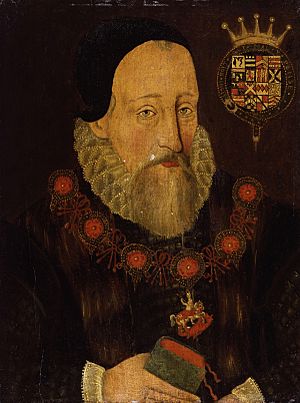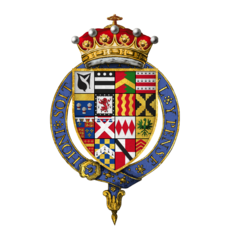Henry Hastings, 3rd Earl of Huntingdon facts for kids
Quick facts for kids
Henry Hastings, 3rd Earl of Huntingdon
|
|
|---|---|

The Earl of Huntingdon
|
|
| Born | 1535 Ashby-de-la-Zouch, Leicestershire, England |
| Died | (aged 59/60) York, England |
| Resting place | St Helen's Church, Ashby-de-la-Zouch |
| Title | Earl of Huntingdon |
| Other titles | Baron Hastings |
| Spouse(s) | Lady Katherine Dudley |
| Parents | Francis Hastings, 2nd Earl of Huntingdon Catherine Pole |
| Occupation | Administrator, diplomat, and military commander |
|
|
|
Henry Hastings, 3rd Earl of Huntingdon (born around 1535, died 14 December 1595) was an important English nobleman. He was a Puritan, which meant he followed a strict form of Protestantism. Henry Hastings was educated with the future Edward VI, who became king.
He was briefly put in prison by Queen Mary I. Later, some people thought he might become the next ruler after Elizabeth I. Henry Hastings strongly disagreed with the idea of Mary, Queen of Scots, marrying the Duke of Norfolk. Queen Elizabeth trusted him to make sure Mary, Queen of Scots, did not escape during a planned uprising in 1569. He worked as the President of the Council of the North from 1572 until he died in 1595.
Contents
Henry Hastings' Early Life
His Education and Family History
Henry Hastings was born in Ashby-de-la-Zouch, a town in Leicestershire, England. This was in 1535 or 1536. He was the oldest son of Francis Hastings, 2nd Earl of Huntingdon, and Catherine Pole.
Through his mother, Henry was related to George Plantagenet, 1st Duke of Clarence. George was the brother of King Edward IV. This family connection meant Henry had a small claim to the English throne. At first, Henry was taught by private teachers at his family's home.
When he was a bit older than Edward VI, Henry was invited to study with the young prince. He had famous tutors like Richard Cox and John Cheke. These teachers gave both boys an education based on Humanism. Humanism was a way of thinking that focused on human values and reason. In 1548, Henry spent a short time at Queens' College, Cambridge. He was greatly influenced by the strong Protestant ideas he found there.
Marriage and Imprisonment
Henry's father was a political friend of John Dudley, 1st Duke of Northumberland. To make their friendship stronger, the two fathers arranged for their children to marry. So, on 21 May 1553, Henry married Katherine Dudley. She was the daughter of Northumberland.
In 1553, King Edward VI was dying. He chose his cousin, Lady Jane Grey, to be his heir. Lady Jane Grey was also Northumberland's daughter-in-law. Lady Jane's rule lasted only from July 10 to July 19, 1553. Then, her cousin Mary Tudor became queen.
Because of his marriage, Henry supported Northumberland's plan to make Lady Jane Grey queen. When Queen Mary I won, Henry was put in the Tower of London. However, Mary tried to make peace with the Hastings family. Soon, they were free and promised to be loyal to her.
Henry then joined the household of his great-uncle, Cardinal Reginald Pole. He traveled with him to places like Calais and Flanders. They also went to monasteries in Smithfield, London. Henry and his great-uncle also helped escort Philip II of Spain to England. Philip came from the Netherlands to marry Queen Mary. Even though Henry was loyal to Mary and his great-uncle, he followed Calvinism. This was another form of Protestantism. He spent a lot of money supporting his puritan beliefs. Many important people, like John Brinsley the elder and Thomas Cartwright, received help from his family.
Henry Hastings' Political Career
Becoming Earl of Huntingdon
Henry had been loyal to King Edward VI, Lady Jane Grey, and Queen Mary I during their reigns. His father was still an important politician. When Queen Mary I died without children, her younger half-sister Elizabeth I became queen in 1558. The new queen also relied on the Hastings family for support.
Henry and his father were called to the House of Lords for Elizabeth's first parliament. They attended regularly. They were present when important laws like the Acts of Supremacy and Uniformity were passed in 1559. Queen Elizabeth made Henry a Knight of the Bath.
Henry's father died on 25 January 1560. Henry then became the third Earl of Huntingdon. This meant he was now responsible for his widowed mother and his ten brothers and sisters.
Slow Rise to Power
Henry had a good education and experience at court. His brother-in-law, Robert Dudley, was also a favorite of the new queen. So, Henry might have expected to get ahead quickly. However, at that time, few members of the Tudor dynasty were still alive. Several people related to the old English royal house of Plantagenet were seen as possible heirs to the throne.
Henry was one of these possible heirs. He gained some support, especially from Protestants. These Protestants were also against another claimant, Mary, Queen of Scots. Henry soon found that his Plantagenet family history actually held him back. When Elizabeth got sick with smallpox in October 1562, a Protestant group suggested him as a possible successor. He tried his best to show Elizabeth his loyalty. But after this, the queen was very slow to give him important jobs outside his home county of Leicestershire.
President of the Council of the North
Still, Henry was useful to Queen Elizabeth. People likely felt that because Henry himself had a claim to the crown, he would not support Mary, Queen of Scots' claim. For three months in the autumn of 1569, during a northern uprising, he helped move the Scottish queen. He moved her from Wingfield Manor to Tutbury. Mary, Queen of Scots, often mentioned him negatively in her secret letters to the French ambassador. Later, in 1586, he was one of the noblemen at her trial.
Queen Elizabeth officially recognized his service. She made him a Knight of the Garter in April 1570. From this time, she seemed to consider him for a promotion. The rebellion of the earls showed that the previous president of the council in the north was not effective. So, in 1572, Henry Hastings was appointed president of the Council of the North. During this time, northern England was a buffer zone against Scotland. Scotland was still very unstable after Mary's escape.
Henry was also very active in preparing for the Spanish invasion in 1588.
Later Life and Legacy
In the autumn of 1595, Henry went north to Newcastle to check on the soldiers. He planned to join his wife at court for Christmas. But when he returned to York in late November, he became sick with a fever. He died there on 14 December 1595.
At court, Queen Elizabeth went out of her way to comfort his sad widow. However, she did little to help with his many debts. Henry had no children of his own. He had educated Francis Hastings, his brother's oldest son, to be his heir. He even sent Francis to Geneva for a time. Francis's ten-year-old son, Henry, was being raised in his great-uncle's home in York in 1595.
Henry's brother, Sir George Hastings, tried to avoid dealing with Henry's estate. This was because Henry had died without a will. But the queen insisted that Henry be given a funeral fitting his rank. He was buried with his nephew, Francis, who died just three days after him. They were buried at St Helen's Church, Ashby-de-la-Zouch, on 26 April 1596.
A painting of Henry Hastings in armor from 1588 is now in the Tower of London. Henry was also responsible for putting together a detailed history of the Hastings family. A handwritten copy of this history is now in the British Museum.
Images for kids
-
Detail from the Vaughan Porch of Leicester Cathedral. The Earl of Huntingdon is 3rd from the right



